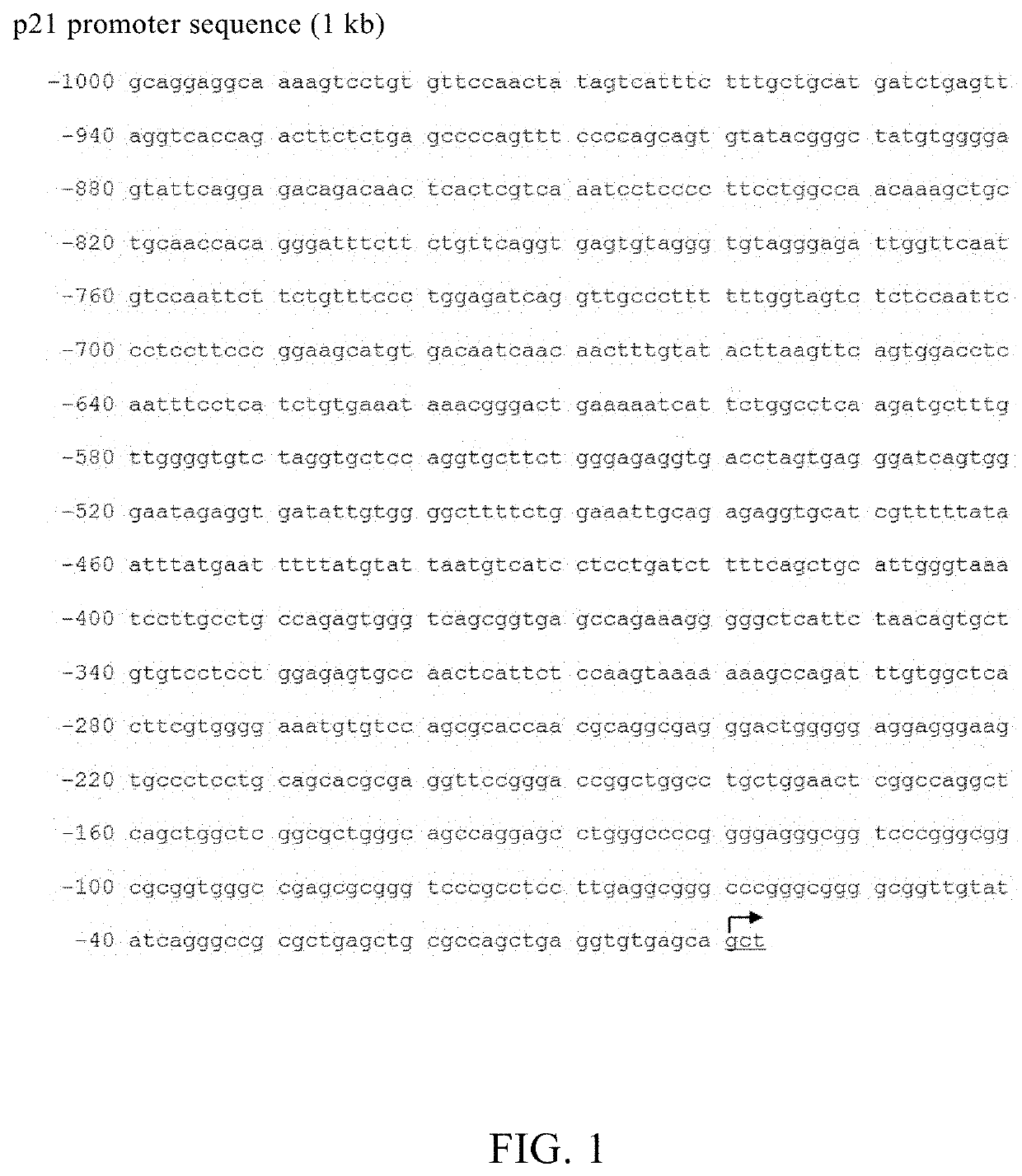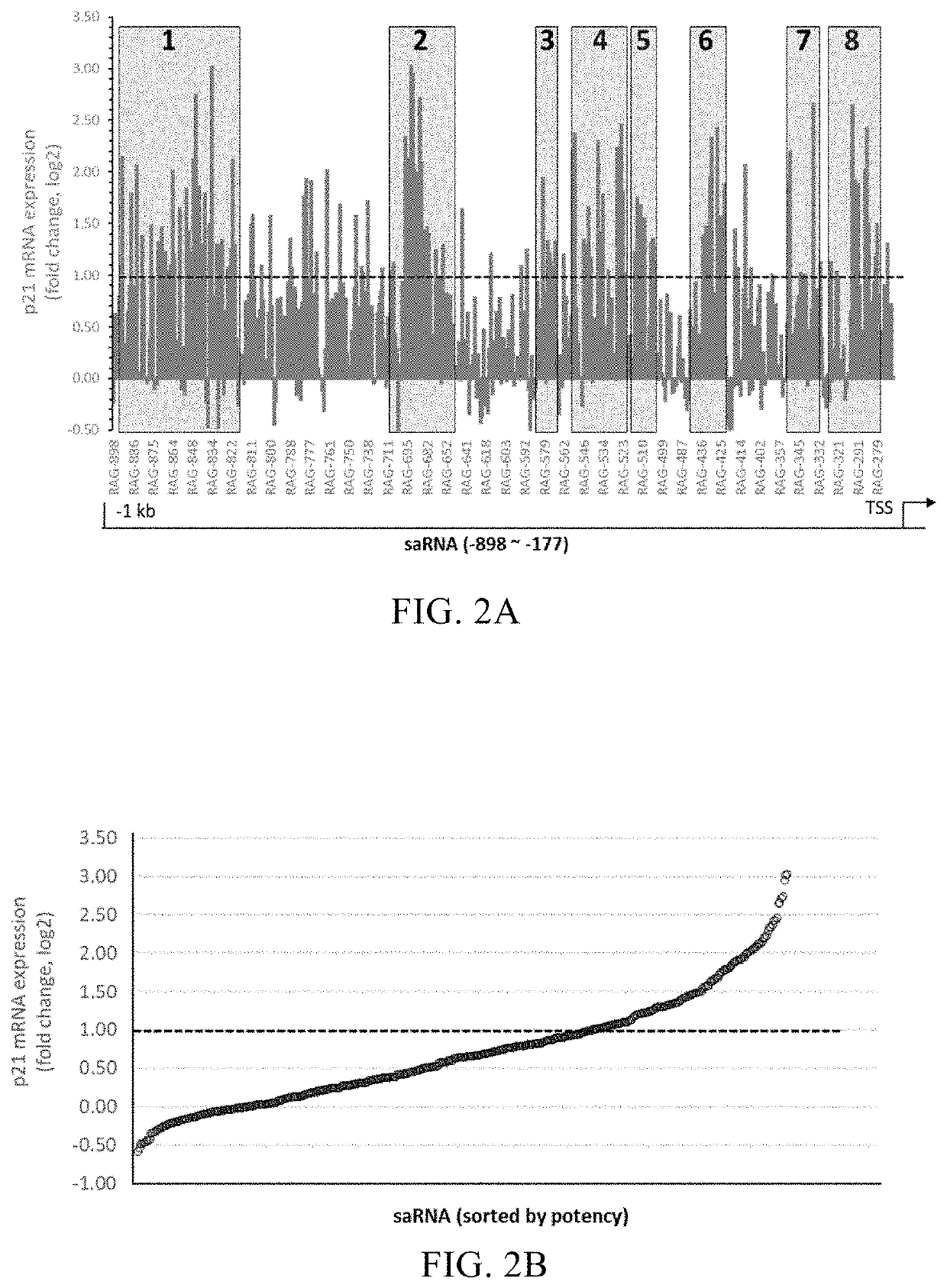Novel Small Activating RNA
a technology of small activation and gene, applied in the field of molecular biology, can solve the problems of adverse effects on the integrity of the host genome, adverse effects on the immunological effect, and the inherent drawbacks of the virus-based system, and achieve the effect of effective upregulation of the targeted gene and effective biological
- Summary
- Abstract
- Description
- Claims
- Application Information
AI Technical Summary
Benefits of technology
Problems solved by technology
Method used
Image
Examples
example 1
of Functional saRNAs Targeting the Promoter Region of p21 Gene
[0084]The coding strand (FIG. 1) for the 1 kb promoter sequence of p21 (SEQ ID NO:601) was retrieved from the UCSC Genome database to screen for functional saRNAs capable of activating p21 gene expression. A total of 982 target sequences were obtained by selecting a target with a size of 19 bp starting from the −1 kb position upstream of the TSS and moving toward the TSS one base pair (bp) at a time. The target sequences were filtered to remove those that have a GC content higher than 65% or lower than 35% and those contain 5 or more consecutive nucleotides. After filtration of the target sequences, 439 target sequences remained and were used as candidates for screening. A RNA sequence of 19 nucleotides in size with 100% sequence homology with each of the candidate target sequence was synthesized chemically, and a dTdT dinucleotide was added to its 3′ terminus to obtain a sense strand with a structural formula as S19+[3T2...
example 2
duce p21 mRNA Expression and Inhibit Cancer Cell Proliferation
[0090]In order to further evaluate the effect of p21 saRNAs in inducing p21 mRNA expression and suppressing cancer cell proliferation, the saRNAs (RAG1-431, RAG1-553 and RAG1-688) screened by QuantiGene 2.0 were transfected into cancer cell lines including Ku-7-luc2-GFP (bladder cancer), HCT116 (colon cancer) and HepG2 (hepatocellular carcinoma). The result showed that in the aforementioned cell lines, all saRNAs could induce at least a two-fold change in the p21 mRNA expression levels and suppress cell proliferation, indicating functional activation of p21 protein. Specifically, RAG-431, RAG-553, and RAG-688 were individually transfected into Ku-7-luc2-GFP cells, caused a 14.0, a 36.9, and a 31.9-fold change in the mRNA expression of p21, and exhibited a 71.7%, 60.7% and 67.4% cell survival rate respectively relative to blank control (Mock) (FIG. 5). RAG-431, RAG-553 and RAG-688 were transfected into the HCT116 cells, re...
example 3
creening and Optimizing saRNAs in a Hotspot Region
[0091]In order to screen and validate p21 activating saRNAs, a more focused screen was performed against hotspot 7 which is a 40 bp region from −332 to −292 relative to the TSS of p21. This region contains 17 overlapping 19-bp saRNA target sites after a short polyadenosine repetitive sequence was excluded (FIG. 8). Seventeen saRNAs with standard structure (19 nt symmetric duplex region with 3′ dTdT overhangs) corresponding to each of the 17 targets were synthesized and named, according to their target positions relative to the TSS, as P21-297, P21-298, P21-299, P21-325, and so on. All the duplex sequences are listed in Table 1. Each of the duplexes was transfected into Ku-7-luc2-GFP (bladder urothelial carcinoma) cells individually, and 72 hours after transfection, p21 mRNA expression levels were detected. As shown in FIG. 9, multiple duplexes (i.e. P21-321, P21-322, and P21-331) are strong activators for p21, resulting in about 4- t...
PUM
| Property | Measurement | Unit |
|---|---|---|
| Fraction | aaaaa | aaaaa |
| Length | aaaaa | aaaaa |
Abstract
Description
Claims
Application Information
 Login to View More
Login to View More - R&D
- Intellectual Property
- Life Sciences
- Materials
- Tech Scout
- Unparalleled Data Quality
- Higher Quality Content
- 60% Fewer Hallucinations
Browse by: Latest US Patents, China's latest patents, Technical Efficacy Thesaurus, Application Domain, Technology Topic, Popular Technical Reports.
© 2025 PatSnap. All rights reserved.Legal|Privacy policy|Modern Slavery Act Transparency Statement|Sitemap|About US| Contact US: help@patsnap.com



